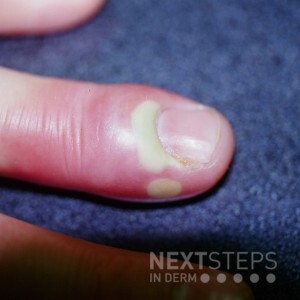
The correct answer is A. Cetuximab.
Epidermal growth factor receptor (EGFR) antagonists are most commonly associated with paronychia.
Methotrexate is mostly commonly associated with ulceration over pressure areas. Vemurafenib would be associated with squamous cell carcinomas or keratoacanthomas, not paronychia. 5-Fluorouracil can cause serpentine hyperpigmentation overlying the veins proximal to the infusion site. Bleomycin can cause Raynaud’s phenomenon, not paronychia.
References:
Guggina, Lauren M.; Choi, Andrew W.; Choi, Jennifer N. (2018): EGFR Inhibitors and Cutaneous Complications: A Practical Approach to Management. Adis Journals. Online resource.
